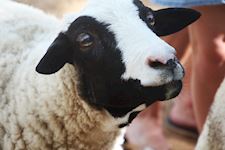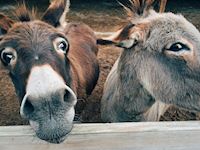Animal Husbandry I - Endorsed Certificate Course (TQUK - Training Qualifications UK)
Distance learning course with study materials, tutor support and final exam included
Academy For Distance Learning
Summary
- Exam(s) / assessment(s) is included in price
- Tutor is available to students
Add to basket or enquire
Overview
Animal Husbandry I - Animal Anatomy And Physiology Online Course.100 Hours Endorsed Certificate Course (TQUK - Training Qualifications UK).
Working with animals? Get back to basics! Gain a thorough foundation knowledge of animal anatomy and physiology.
This is essential for careers requiring good animal care and management. An excellent starting point for working with animals in any situation (farms, pets, zoos, wildlife, animal protection). Learn at your own pace through distance learning.
Benefits of an ADL Endorsed Course?
Endorsed courses are skills based. They have been evaluated and approved by an independent awarding body such as Training Qualifications UK (TQUK).
What makes ADL’s Endorsed courses different?
- Flexible Self-Paced Learning– adjust your learning around your home and work commitments
- Start and Finish at any time
- Courses globally and industry relevant
- Practical Component at the end of most lessons.
Allocated your own tutor relevant to your subject. You can have as little or as much contact as you like with your tutor. They are there to support you all the way through.
This course is endorsed by TQUK -Training Qualifications UK, an OFQUAL awarding body.
Achievement
Course media
Description
Lesson Structure:
1 Introduction to cells & tissues;
- Livestock classes
- Livestock products
- Interrelationship between crops and livestock
- Cells and tissues
- Special properties of cells
- Osmosis
- Nutrient waste
2 The Digestive System;
- Digestive system
- Mouth
- Tongue
- Teeth
- Oesophagus
- Simple stomach
- Small intestine
- Large intestine
- Ruminant stomach
- Accessory organs of the digestive system
- Digestion, absorption and utilisation in the simple stomach
- Enzymes
- Breakdown by microorganisms
- Digestion, absorption and utilisation in the ruminant stomach
- Mechanical action
- Action of micro-organisms
- Utilisation of the end products of digestion
3 The Circulatory System;
- Circulatory system
- Composition of blood
- Functions of blood
- Clotting mechanism
- Immunity
- Blood vessels
- Arteries, veins, capillaries
- Physiology of the circulatory system
- Rates of heart beats
- Spleen
- Lymphatic system
- Circulatory networks
4 The Urinary System;
- Anatomy of the urinary system,
- Kidneysureter, bladder
- physiology of urinary system
- Excretion in different animals.
5 The Nervous System;
- Central and peripheral nervous system
- Main parts of the nervous system
- Nneurones, sensory neurones, motor neurones
- Central nervous system
- The brain
- Spinal cord
- Peripheral nervous system
- Cranial nerves
- Spinal nerves
- Aautonomic nervous system
- Reflex actions
- Endocrine system
- Structure and function of the ear: Hearing
- Structure and function of the eye: The iris
- Structure and function of the nose.
6 Respiration;
- Anatomy of respiration
- Trachea
- Bronchial tree
- Lungs
- Physiology of respiration
- Gaseous exchange Rate and depth of breathing.
7 The Reproductive System;
- Anatomy of the male reproductive system: testes, accessory organs, physiology of male reproductive system, hormone production, sperm production, erection, ejaculation, fertility problems in males, Venereal diseases
- Other diseases
- Injury,
- Physical immaturity Emotional immaturity
- Nutrition
- Poor handling
- Anatomy of female reproductive system, ovaries, fallopian tubes, uterus, cervix, physiology of the female reproductive system, ovulation, oestrus cycle, fertility problems, difficulties conceiving,
- Venereal and other diseases
- Physical abnormalities
- Nutrition
- Inability to carry a foetus to full term
- Pregnancy and parturition
- Fertilisation
- Pregnancy
- Parturition
- Birth process
- Difficult births
- Structure of the mammary glands
- Secretion of milk
- Milk ejection
- Reproduction data for cows, sows and ewes.
8 Muscles & Meat;
- Muscles and meat
- Smooth muscle
- Striated voluntary muscle
- Cardiac muscle, structure of meat
- Dressing out percentage
- Composition of the beef animal
- Meat quality and tenderness
- Juiciness, flavour, cuts and joints of meat.
9 The Skeleton;
- Bones
- How bones are formed
- Anatomy of bones
- Fractures and fracture healing
- Five types of bone
- Joints of bone
- The skeleton
- Dentition
- The dental formula
- Cattle, dental formula of an ox and cow
- Eruption of permanent teeth
- Pigs
10 Animal Growth, Development, and the Endocrine System;
- Growth and development
- Growth curve
- Prenatal growth
- Post-natal growth
- Fat
- Factors which affect the size of newborns
- Factors affecting post-natal growth
- Early maturing
- Compensatory growth
- Endocrine system
- Pituitary gland
- Thyroid
- Parathyroid
- Thymus
- Adrenal bodies
- Pancreas
- Testes
- Ovaries
- Pineal body
- Mucous membrane of the stomach
11 Comparing Different Animals;
- Poultry
- Digestion
- Gullet
- Crop
- Proventriculus
- Gizzard
- Intestine
- Caecum
- Rectum
- Incubating eggs
- Natural incubation
- Symptoms of a broody hen
- Fish
Each lesson culminates in an assignment which is submitted to the academy, marked by the academy's tutors and returned to you with feedback, any relevant suggestions, comments, and if necessary, extra reading.
Who is this course for?
Animal Enthusiasts, Animal Breeders, Agriculturalists, Farmers
Requirements
A pc or laptop with internet connection.
Career path
An excellent starting point for working with animals in any situation (farms, pets, zoos, wildlife, animal protection). Learn at your own pace through distance learning. It is also an excellent vocational pathway towards employment in the Veterinary industry.
Questions and answers
Currently there are no Q&As for this course. Be the first to ask a question.
Reviews
Currently there are no reviews for this course. Be the first to leave a review.
Legal information
This course is advertised on reed.co.uk by the Course Provider, whose terms and conditions apply. Purchases are made directly from the Course Provider, and as such, content and materials are supplied by the Course Provider directly. Reed is acting as agent and not reseller in relation to this course. Reed's only responsibility is to facilitate your payment for the course. It is your responsibility to review and agree to the Course Provider's terms and conditions and satisfy yourself as to the suitability of the course you intend to purchase. Reed will not have any responsibility for the content of the course and/or associated materials.





